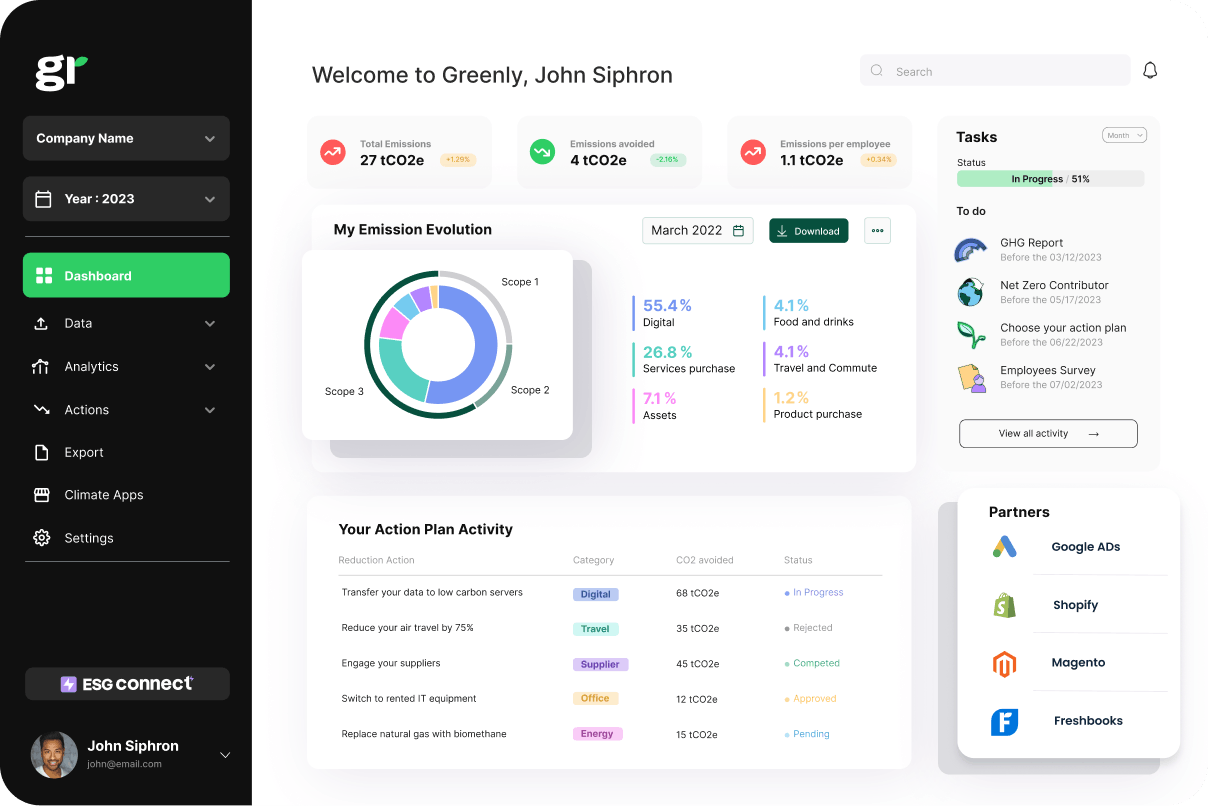
What are the 3 Pillars of Corporate Sustainability?
In this article, we'll explore what the 3 pillars of corporate responsibility are, why they're important, and how businesses can turn them into practical action.
ESG / CSR
Industries



Sustainability leadership is becoming more complex and demanding than ever before. As we move into 2025, Chief Sustainability Officers (CSOs) face mounting pressure to deliver measurable results while balancing evolving regulations, stakeholder expectations, and climate realities. No longer confined to compliance or reporting, the role now demands strategic influence at the highest levels of business operations.
To thrive in this evolving landscape, CSOs must navigate a series of critical challenges, from embedding sustainability into core business strategies to ensuring transparent reporting and driving genuine climate action. Each challenge presents both risks and opportunities for businesses committed to long-term success.
👉 In this article, we’ll explore the key battles every CSO manager will need to win in 2025, with actionable insights on how to stay ahead of the curve and make a lasting impact.
The regulatory landscape for sustainability is rapidly evolving, with governments and international bodies imposing stricter reporting requirements and accountability measures. For CSO managers in 2025, staying ahead of these changes will be critical - not just for compliance but for maintaining credibility and avoiding reputational risk.
Recent frameworks such as the Corporate Sustainability Reporting Directive (CSRD) in the EU and the SEC's climate disclosure rules in the US reflect a global shift toward greater corporate accountability. These regulations demand detailed, standardised reporting on carbon emissions, resource usage, and climate risk management. Falling behind on compliance could lead to penalties, investor scrutiny, and public mistrust.
To stay proactive, CSOs should integrate sustainability governance into the broader corporate strategy. This means establishing systems to track and verify data, ensuring transparency, and keeping leadership teams informed about policy shifts. Partnering with legal experts and sustainability consultants can help businesses interpret complex regulations and stay compliant.
Ultimately, the battle isn’t just about meeting minimum requirements, it's about using regulatory frameworks as a foundation for stronger, more accountable sustainability leadership.
Key sustainability regulations CSO managers in the UK and US should be aware of in 2025 include:
| Region | Regulation | Key Requirements | Who It Applies To |
|---|---|---|---|
| UK | Corporate Sustainability Reporting Directive (CSRD) | Mandatory sustainability disclosures including carbon emissions, climate risks, and supply chain data. | Large companies with 250+ employees, €25M+ balance sheet, or €50M+ turnover. |
| Streamlined Energy and Carbon Reporting (SECR) | Annual reporting on energy use, emissions, and energy efficiency measures. | Quoted companies, large unquoted companies, and LLPs. | |
| Task Force on Climate-related Financial Disclosures (TCFD) | Disclosure of climate-related risks and governance strategies. | Premium listed companies, banks, insurers, and large private companies. | |
| US | SEC Climate Disclosure Rules | Standardised reporting of climate risks, emissions data, and mitigation strategies. | Publicly listed companies. |
| California Climate Accountability Package (SB 253 & SB 261) | Mandatory Scope 1, 2, and 3 emissions reporting and climate-related financial risk disclosure. | Large companies doing business in California with revenues above $1B. | |
| Inflation Reduction Act (IRA) | Incentives for clean energy investments and emissions reduction efforts. | Companies investing in renewable energy projects and energy efficiency upgrades. |
Sustainability is a fundamental driver of long-term business success. As a CSO in 2025, the challenge lies in embedding sustainability into the core of corporate strategy, moving beyond compliance and public commitments to influence decision-making at every level of the organisation.
A key battle for CSOs is shifting sustainability from being perceived as a cost centre to a value driver. This means clearly linking sustainability goals with financial performance, such as demonstrating how energy efficiency measures reduce operational costs or how circular economy models can unlock new revenue streams. Companies with strong sustainability strategies often enjoy greater investor confidence, enhanced brand reputation, and resilience against market disruptions.
To achieve this, CSOs need to:
By positioning sustainability as a core part of business growth, CSOs can ensure long-term success while making meaningful progress toward environmental and social impact goals.
In 2025, stakeholder expectations around corporate sustainability will continue to grow, placing increasing pressure on CSOs to balance transparency, accountability, and genuine progress. Investors, customers, employees, and regulatory bodies all demand clear, measurable sustainability commitments - and they expect results, not just promises.
A key challenge for CSOs lies in avoiding the perception of greenwashing. Vague commitments without concrete data or clear progress can damage a company's reputation and erode stakeholder trust. The battle here is twofold: ensuring that sustainability goals are both ambitious and realistic while communicating them transparently.
To manage stakeholder expectations effectively, CSOs can:
Building trust through consistent, honest communication will be essential in maintaining stakeholder support while driving long-term sustainability progress. A proactive approach not only strengthens relationships but also helps position the company as a responsible industry leader.

The climate crisis is no longer a distant threat - it’s a defining challenge for businesses today. As a CSO in 2025, leading meaningful climate action will be central to sustainability leadership. Companies face mounting pressure to move beyond vague net zero claims and take measurable steps to reduce their environmental impact.
The key battle here is ensuring that climate commitments translate into genuine, science-based action rather than symbolic gestures. Stakeholders expect more than just offsets - they want to see proactive efforts to cut emissions across the entire value chain.
Key strategies for CSOs include:
By taking measurable steps, CSOs can position their organisations as leaders in climate resilience while reducing long-term operational risks.

In 2025, technology will be a key driver in advancing sustainability goals, but leveraging it effectively requires strategic decision-making. As a CSO, the challenge lies in identifying the right tools to measure, manage, and accelerate sustainability efforts without becoming overly reliant on data-driven solutions that fail to drive genuine impact.
Sustainability technology has evolved beyond basic carbon accounting platforms. Today, CSOs can access advanced tools for lifecycle analysis, real-time emissions tracking, and AI-powered forecasting. However, the battle is ensuring these tools support meaningful progress rather than just enhancing reporting capabilities.
Key strategies for CSOs include:
What about Greenly?
Greenly offers a suite of carbon management services designed to help businesses track, measure, and reduce their emissions effectively. With tools for Scope 1, 2, and 3 emissions tracking, supplier collaboration, and actionable insights, Greenly empowers CSOs to make data-driven decisions that lead to real sustainability progress. Our platform combines emissions data with practical reduction strategies - ensuring companies can go beyond reporting to make a measurable impact on their sustainability journey.
In 2025, supply chain sustainability will be one of the most critical challenges for CSOs to address, given that Scope 3 emissions often represent the largest share of a company’s carbon footprint. Managing these indirect emissions requires both collaboration and accountability across global supplier networks.
The core challenge lies in balancing cost efficiency with sustainability progress. Many businesses rely on complex, multi-tiered supply chains where transparency is limited, making it difficult to assess environmental impact and ethical practices at every stage. However, regulators and stakeholders are increasingly holding companies accountable for not just their direct emissions but those embedded throughout their value chains.
Key strategies for CSOs to drive supply chain sustainability include:
What about Greenly?
Greenly supports businesses in making their supply chains more sustainable by providing tools to assess and reduce Scope 3 emissions. Through supplier engagement tools and access to a network of sustainable vendors, Greenly helps CSOs identify high-impact areas for intervention while ensuring accountability and progress across the value chain.
Sustainability cannot succeed as a top-down directive - it requires genuine cultural transformation throughout the organisation. As a CSO in 2025, one of the greatest challenges will be embedding sustainability into the company’s values and day-to-day operations, ensuring it becomes part of the corporate mindset rather than a siloed initiative.
A sustainability-driven culture not only enhances employee engagement but also drives innovation and long-term performance. However, the battle lies in avoiding performative gestures and instead cultivating meaningful behavioural change across all levels of the business.
Key strategies for CSOs to build a sustainability-focused culture include:

In 2025, accurate measurement and transparent reporting will remain pivotal for CSOs seeking to demonstrate genuine progress in sustainability. Companies are increasingly expected to disclose not just their emissions data but also the effectiveness of their reduction strategies, making performance metrics a core part of sustainability leadership.
However, the challenge lies in balancing comprehensive data collection with clarity. Overcomplicated reports filled with dense metrics can overwhelm stakeholders, while oversimplified disclosures risk appearing vague or incomplete. Striking the right balance (data-driven yet accessible) is critical.
Key strategies for CSOs include:
Visual reporting tools: Leverage dashboards, infographics, and summary visuals to present complex data in an understandable format for all stakeholders.

The role of a Chief Sustainability Officer (CSO) in 2025 will be more critical - and challenging - than ever. From navigating complex regulatory landscapes and embedding sustainability into core strategies to managing stakeholder expectations and driving climate action, the battles ahead will require strategic leadership, collaboration, and transparency.
Winning these battles isn’t just about compliance or reputation management. It’s about future-proofing the business, creating long-term value, and positioning the company as a leader in sustainable innovation. By leveraging the right tools, such as comprehensive carbon management platforms, and building a culture where sustainability is a shared responsibility, CSOs can drive genuine progress.
Ultimately, the key to success lies in staying proactive, transparent, and committed to continuous improvement. CSOs who can balance ambition with accountability will not only meet rising expectations but also contribute to a more sustainable and resilient global economy.
Greenly empowers businesses to take control of their sustainability strategies by offering a suite of carbon management services designed to simplify emissions tracking, reporting, and reduction. Here's how Greenly supports CSOs in winning the key battles of 2025:
By combining advanced data insights with actionable strategies, Greenly helps CSOs drive measurable progress while maintaining transparency and accountability, making sustainability leadership more effective than ever. Get in touch with us today to find out more.
